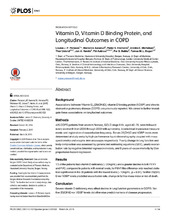| dc.contributor.author | Persson, Louise Jeanette Pauline | en_US |
| dc.contributor.author | Aanerud, Marianne | en_US |
| dc.contributor.author | Hiemstra, Pieter Sicco | en_US |
| dc.contributor.author | Michelsen, Annika | en_US |
| dc.contributor.author | Ueland, Thor | en_US |
| dc.contributor.author | Hardie, Jon Andrew | en_US |
| dc.contributor.author | Aukrust, Pål | en_US |
| dc.contributor.author | Bakke, Per S. | en_US |
| dc.contributor.author | Eagan, Tomas Mikal | en_US |
| dc.date.accessioned | 2016-02-08T12:30:43Z | |
| dc.date.available | 2016-02-08T12:30:43Z | |
| dc.date.issued | 2015-03-24 | |
| dc.Published | PLoS ONE 2015, 10(3):e0121622 | eng |
| dc.identifier.issn | 1932-6203 | |
| dc.identifier.uri | https://hdl.handle.net/1956/11043 | |
| dc.description.abstract | Background: Associations between Vitamin D3 [25(OH)D], vitamin D binding protein (VDBP) and chronic obstructive pulmonary disease (COPD) are previously reported. We aimed to further investigate these associations on longitudinal outcomes. Methods: 426 COPD patients from western Norway, GOLD stage II-IV, aged 40–76, were followed every six-month from 2006 through 2009 with spirometry, bioelectrical impedance measurements and registration of exacerbation frequency. Serum 25(OH)D and VDBP levels were determined at study-entry by high-performance liquid chromatography coupled with mass spectrometry and enzyme immunoassays respectively. Yearly change in lung function and body composition was assessed by generalized estimating equations (GEE), yearly exacerbation rate by negative binomial regression models, and 5 years all-cause mortality by Cox proportional-hazard regression. Results: 1/3 of the patients had vitamin D deficiency (<20ng/mL) and a greater decline in both FEV1 and FVC, compared to patients with normal levels; for FEV1 this difference only reached statistical significance in the 28 patients with the lowest levels (<10ng/mL, p = 0.01). Neither 25(OH)D nor VDBP levels predicted exacerbation rate, change in fat free mass index or risk of death. Conclusion: Severe vitamin D deficiency may affect decline in lung function parameters in COPD. Neither 25(OH)D nor VDBP levels did otherwise predict markers of disease progression. | en_US |
| dc.language.iso | eng | eng |
| dc.publisher | PLOS | eng |
| dc.rights | Attribution CC BY | eng |
| dc.rights.uri | http://creativecommons.org/licenses/by/4.0/ | eng |
| dc.title | Vitamin D, vitamin D binding protein, and longitudinal outcomes in COPD | en_US |
| dc.type | Peer reviewed | |
| dc.type | Journal article | |
| dc.date.updated | 2015-12-21T20:10:04Z | |
| dc.description.version | publishedVersion | en_US |
| dc.rights.holder | Copyright 2015 The Authors | |
| dc.identifier.doi | https://doi.org/10.1371/journal.pone.0121622 | |
| dc.identifier.cristin | 1252935 | |
| dc.subject.nsi | VDP::Medisinske fag: 700::Helsefag: 800::Ernæring: 811 | |
| dc.subject.nsi | VDP::Midical sciences: 700::Health sciences: 800::Nutrition: 811 | |
| dc.subject.nsi | VDP::Medisinske fag: 700::Klinisk medisinske fag: 750::Lungesykdommer: 777 | |
| dc.subject.nsi | VDP::Midical sciences: 700::Clinical medical sciences: 750::Lung diseases: 777 | |
| dc.subject.nsi | VDP::Medisinske fag: 700::Basale medisinske, odontologiske og veterinærmedisinske fag: 710::Medisinsk mikrobiologi : 715 | |
| dc.subject.nsi | VDP::Midical sciences: 700::Basic medical, dental and veterinary sciences: 710::Medical microbiology: 715 | |

